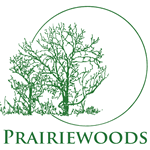On a hot and deeply still July afternoon in 2015, I made my first exploration of the land at Prairiewoods. I didn’t know there were maps of the trails, so I just wandered. Stopping where the path overlooked a bend in Dry Creek I saw, many feet below where I stood, a single large blue-gray bird standing peacefully in the shallow water. I watched it briefly, and then continued on my way.
I had no clear mental picture of the overall parcel of land that comprises Prairiewoods. Hence my surprise when I rounded a turn in the path and found myself near the very spot I had recently seen from above. The bird I had previously observed and I startled one another. If you have never been close enough to flinch as a Great Blue Heron’s wings nearly brushed you in take-off, I assure you—it is memorable.
And so began a series of encounters with other-than-human kin here at Prairiewoods. I met snakes in the hallway that first fall, a crayfish on the sidewalk, a red-tailed hawk who calmly watched me as he ate a small creature he caught not more than three feet from me early one morning. There were deer who visited my window at the Guest House at 3 a.m. when I was caught here during a blizzard, and the unseen frog chorus that serenades Prairiewoods daily from spring to fall.
I learned to recognize and call by name the may apples and the garlic mustard, the service berries and ground cherries. I watched as the espalier pear tree produced its first fruits last summer. I learned to recognize the bur oaks and ash, to appreciate the variety of prairie plants, the energy of bees swarming and had my first awed viewing of monarch butterflies emerging from their chrysali. Late one afternoon I was overcome with emotion as I witnessed the astonishing beauty of the sun’s last rays filtering through a garden bursting with ripeness of tomatoes, plums and nasturtiums.
Before I came to Prairiewoods, I would have said I appreciated nature. I would have said that I sometimes felt the awe of creation. I would even have assured you that I believed everything was connected. But until I came and spent seven years in this sacred space, I never truly understood what it means when we say, “We are One.”
My “we” was so small.
My “are” was so limited.
My “One” so inadequate.
My understanding has expanded here under the tutelage of many teachers and elders. We breathe for, with and because of one another.
At Prairiewoods, I was happy to hear the name of Pierre Teilhard de Chardin, whose works had lit me up in a college course called Christian Anthropology (taught by the incredible Mary Ellen Caldwell, BVM). I hadn’t encountered his work since. Teilhard wrote:
“Seeing. One could say that the whole of life lies in seeing—if not ultimately, at least essentially. To be more is to be more united—and this sums up and is the very conclusion of the work to follow. But unity grows, and we will affirm this again, only if it is supported by an increase of consciousness, of vision. That is probably why the history of the living world can be reduced to the elaboration of ever more perfect eyes at the heart of a cosmos where it is always possible to discern more … To try to see more and to see better is not, therefore, just a fantasy, curiosity, or a luxury. See or perish. This is the situation imposed on every element of the universe by the mysterious gift of existence …”
—Pierre Teilhard de Chardin, The Human Phenomenon
To see more and to see better. This is the gift Prairiewoods offered me—a gift freely and lovingly given by the people, the animals, the trees, the plants, the seen and unseen denizens of this sacred space of peace and transformation. I will be forever grateful.
I will also take with me, though, the urgency of Teilhard’s admonition, which I’ve learned to feel viscerally in these seven years, too: “See or perish.” As we move forward into the future, we must hope it has been significantly altered by the events of the past few years. We must hope that WE have been altered. This is the fire Prairiewoods has kindled in my heart, the fire that crackles and snaps within me as I leave. It too is a gift.
—Jenifer Hanson, Prairiewoods director


